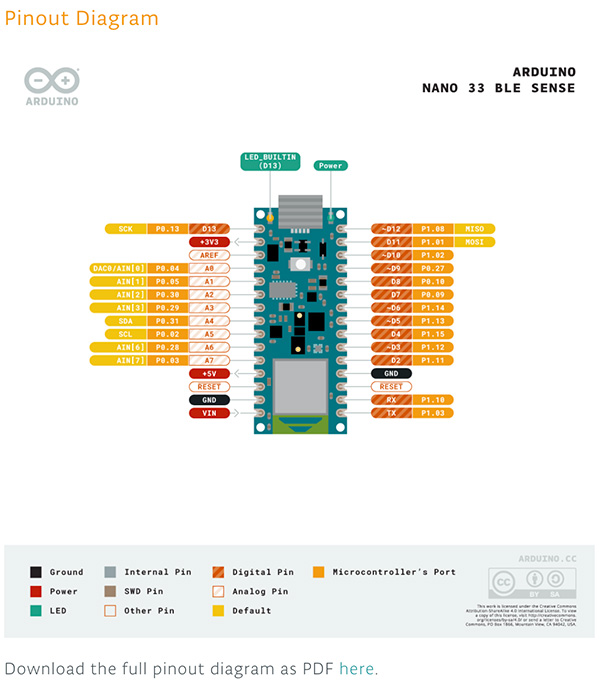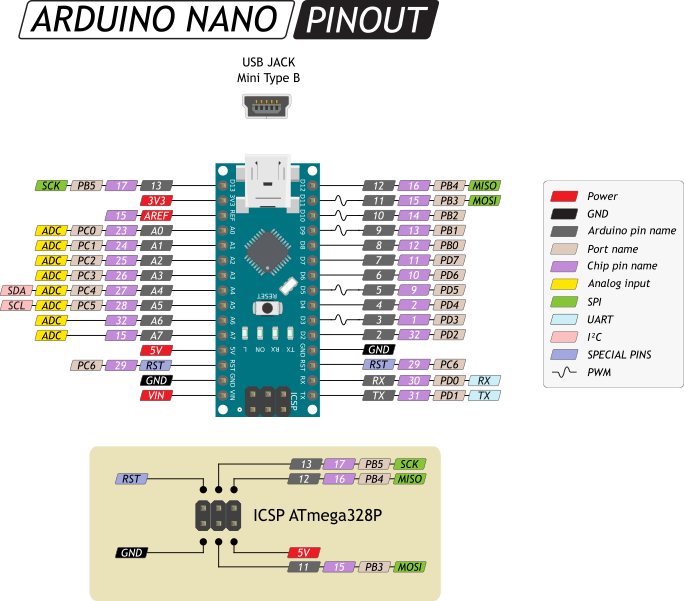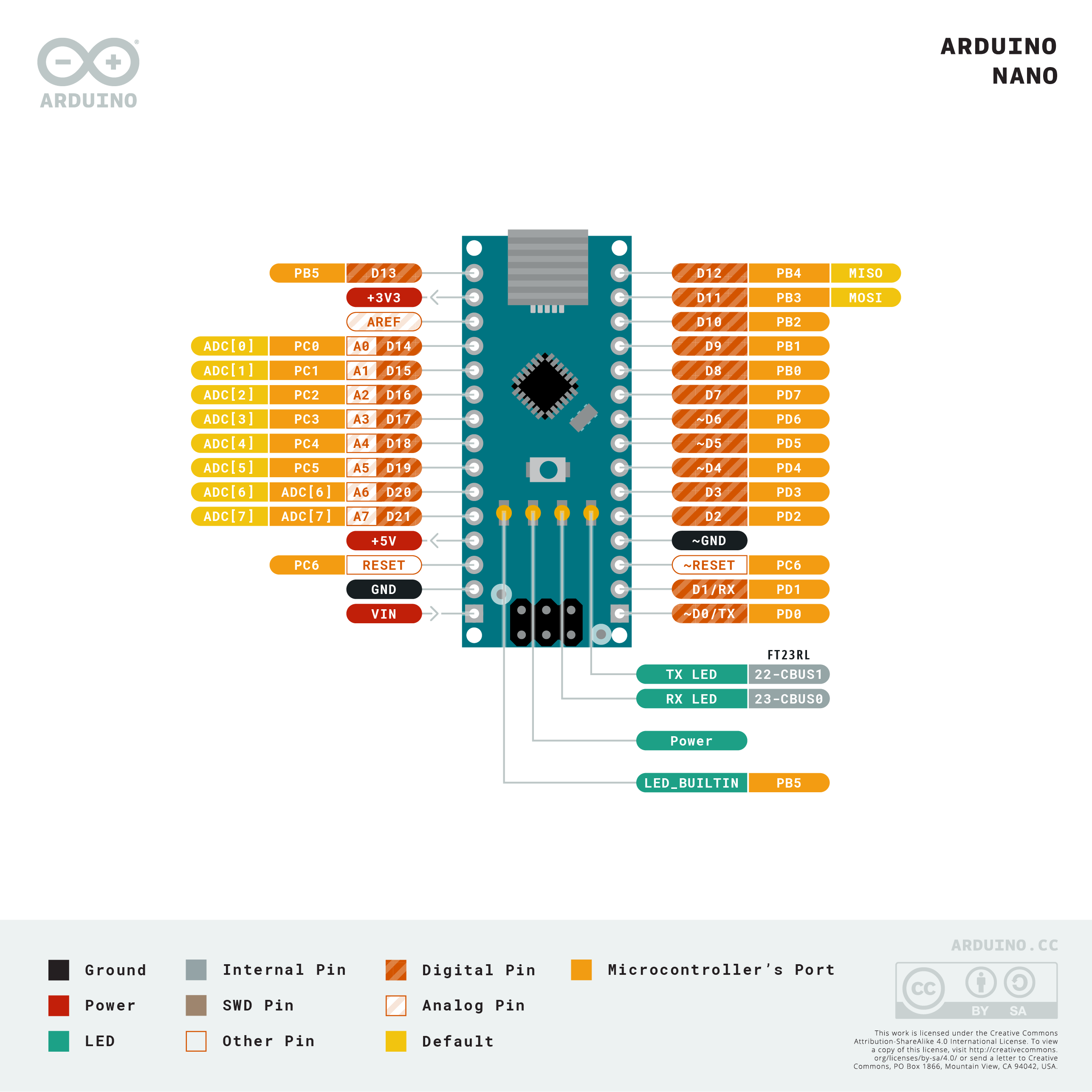
- ARDUINO NANO PINOUT NO 3VOLTS HOW TO
- ARDUINO NANO PINOUT NO 3VOLTS SERIAL
- ARDUINO NANO PINOUT NO 3VOLTS DRIVER
- ARDUINO NANO PINOUT NO 3VOLTS FULL
- ARDUINO NANO PINOUT NO 3VOLTS PRO
ARDUINO NANO PINOUT NO 3VOLTS PRO
The Arduino Pro Mini is a very powerful Arduino with lots of features and I/O in a very small package. "1] The sum of all IOL, for ports C0 - C5, ADC7, ADC6 should not exceed 100mA" - note that this is different from the 150mA for sourcing).īut, again, as long as you're okay with trusting the programming / the components not to fail, then you could easily drive the LEDs directly from this board by just keeping 1 or 2 on at a time :)

then explains in the notes the specific calculations you should perform to see if you exceed the maximum current you can sink per section (e.g. But it's less than the combined 400mA of the GND pins, so you could sink it. That's more than the VCC pin is supposed to handle (in fact, while the maximum per pin current is 40mA, you'll find further down that they prefer 10mA when VCC is 3.0V), so you can't source that much current. 200.0mA" Let's say you wanted all 14 LEDs on at 20mA at the same time, giving a total of 280mA. page 303 the first table (absolute maximum ratings): "DC Current VCC and GND Pins.
ARDUINO NANO PINOUT NO 3VOLTS FULL
Shift registers can generally, thankfully, handle more than just 2 LEDs,but either way your Arduino would only have to deal with a minute amount of current required to drive the shift register, rather than 2, 4 or even the full 14 LEDs.Īs far as the ATmega goes, check e.g. No problem, you would create two patterns, and switch between them really fast so that it still appears as the desired pattern: Now let's say that, theoretically, you, can only have 2 LEDs on at the same time due to current restrictions in the shift register itself.
ARDUINO NANO PINOUT NO 3VOLTS SERIAL
You would then push essentially serial data into the shift register to match that pattern (00001110010000: LEDs 1, 2, 3, 4 off, 5, 6, 7 on, 8, 9 off, 10 on, 11, 12, 13, 14 off). Let's say your signals dictate that you need LEDs 5, 6, 7 and 10 to be on. My plan is to have the Arduino turn LEDs on/off based on the signals it gets from the cars RX But, it's not required as long as you can work within the confines mentioned above. There's many other options, try googling for '16 channel led driver'. Two Shift Register 8-Bit - 74HC595 will decrease current requirements from the Arduino as less pins are used, two Shift Register 8-Bit High-Power - TPIC6B595s could easily drive all 14 at the same time, and a single STP16C596 (suggested at the arduino site) would be practically an all-in-1 solution.
ARDUINO NANO PINOUT NO 3VOLTS DRIVER
Note that a driver board doesn't have to take much extra space. Note that if your program has an error and turns all LEDs on, you would have a problem :) In this case you could also source the current. Another option is to only have a few LEDs on at the same time, turning them on/off as quickly as you can to make them appear to be on all the time, while reducing the current required. This does mean your LEDs will light up less brightly (source nice, bright LEDs if this is a concern). Your safest bet without a driver board would be to simply limit the current below 20mA.
ARDUINO NANO PINOUT NO 3VOLTS HOW TO
See pages 303 and 304 (the notes on page 304 detail how to calculate the maximum ratings based on pin selections) of the datasheet for ATmega328 for details. If you're trying to sink it, then your pin selection matters. If you're trying to source the current, yes. Would I fry the chip by pulling 20ma through 14 of the I/O pins Note: A portion of this sale is given back to Arduino LLC to help fund continued development of new tools and new IDE features. The latest and greatest version of this board breaks out the ADC6 and ADC7 pins as well as adds footprints for optional I2C pull-up resistors! We also took the opportunity to slap it with the OSHW logo.Ĭan't decide which Arduino is right for you? Arduino buying guide! If you're supplying unregulated power to the board, be sure to connect to the "RAW" pin on not VCC. There is a voltage regulator on board so it can accept voltage up to 12VDC. The Arduino Pro Mini also works with the FTDI cable but the FTDI cable does not bring out the DTR pin so the auto-reset feature will not work. This board connects directly to the FTDI Basic Breakout board and supports auto-reset. In order to accomplish this we used all SMD components, made it two layer, etc. We really wanted to minimize the cost of an Arduino. The Arduino Pro series is meant for users that understand the limitations of system voltage (3.3V), lack of connectors, and USB off board. It's a great board that will get you up and running quickly. We recommend first time Arduino users start with the Uno R3.

Arduino Pro Mini does not come with connectors populated so that you can solder in any connector or wire with any orientation you need. This is a 3.3V Arduino running the 8MHz bootloader.

It's blue! It's thin! It's the Arduino Pro Mini! SparkFun's minimal design approach to Arduino.


 0 kommentar(er)
0 kommentar(er)
